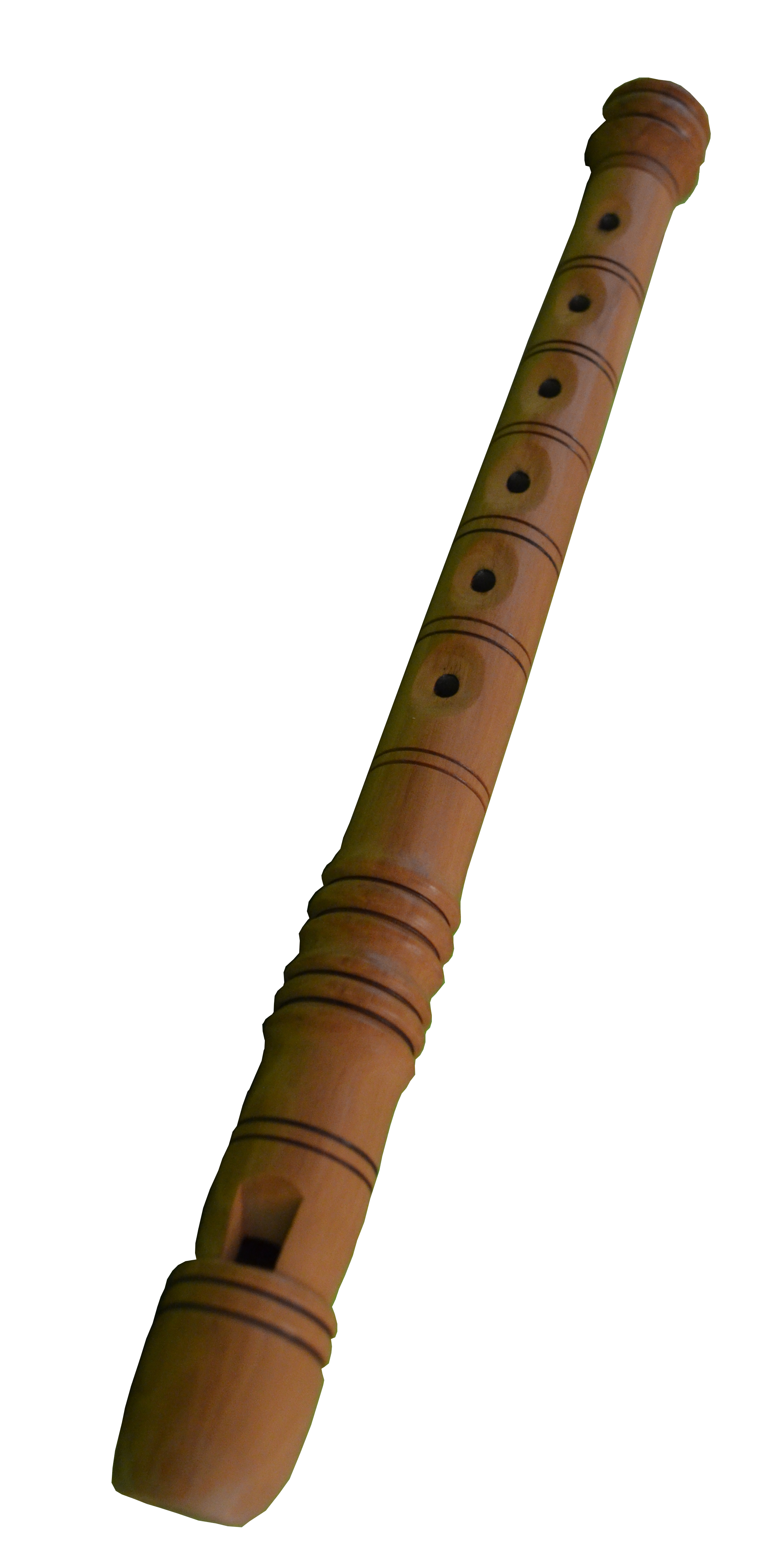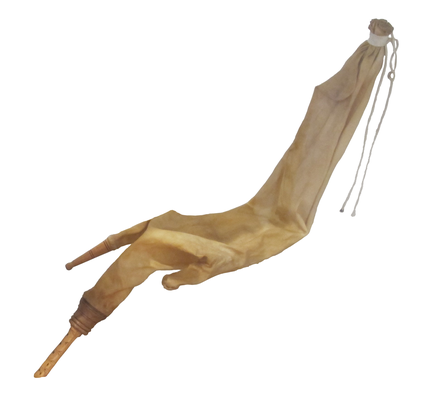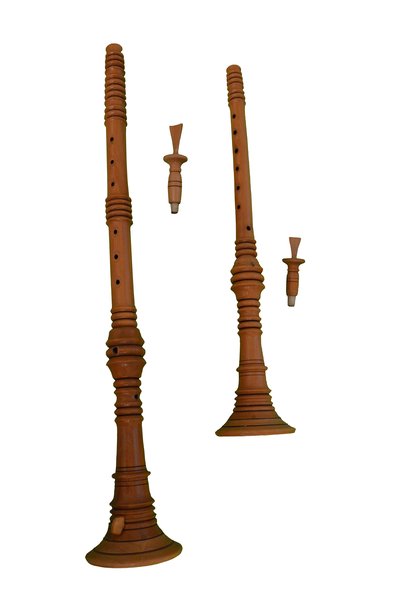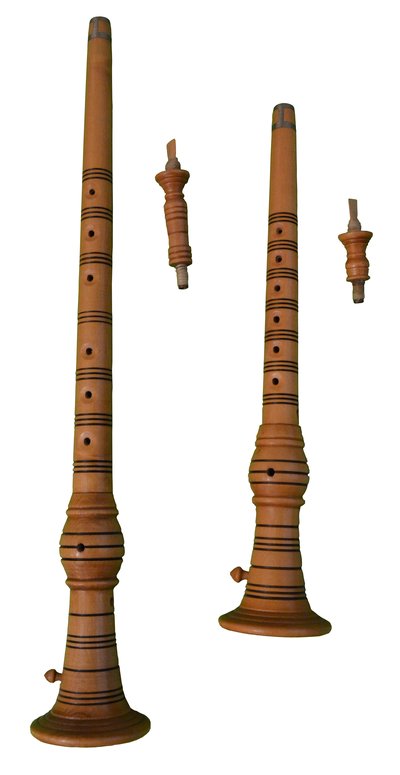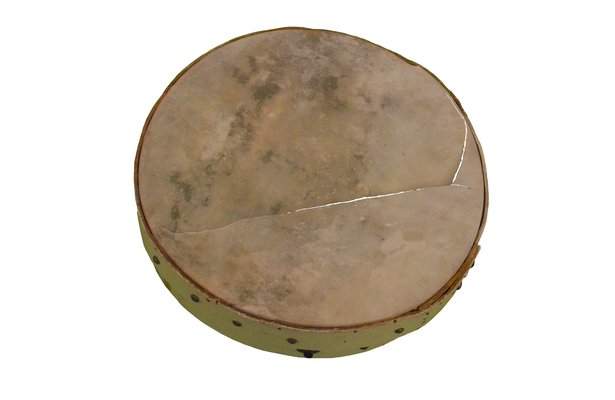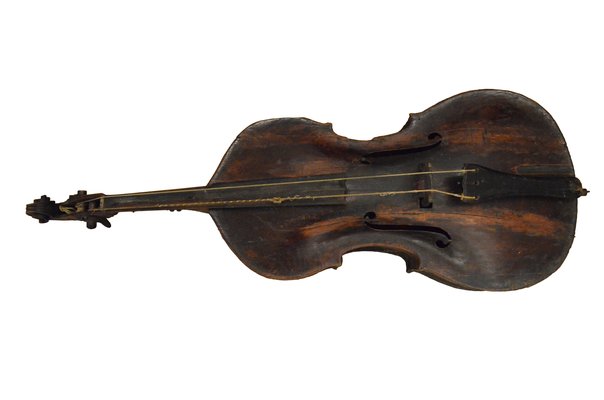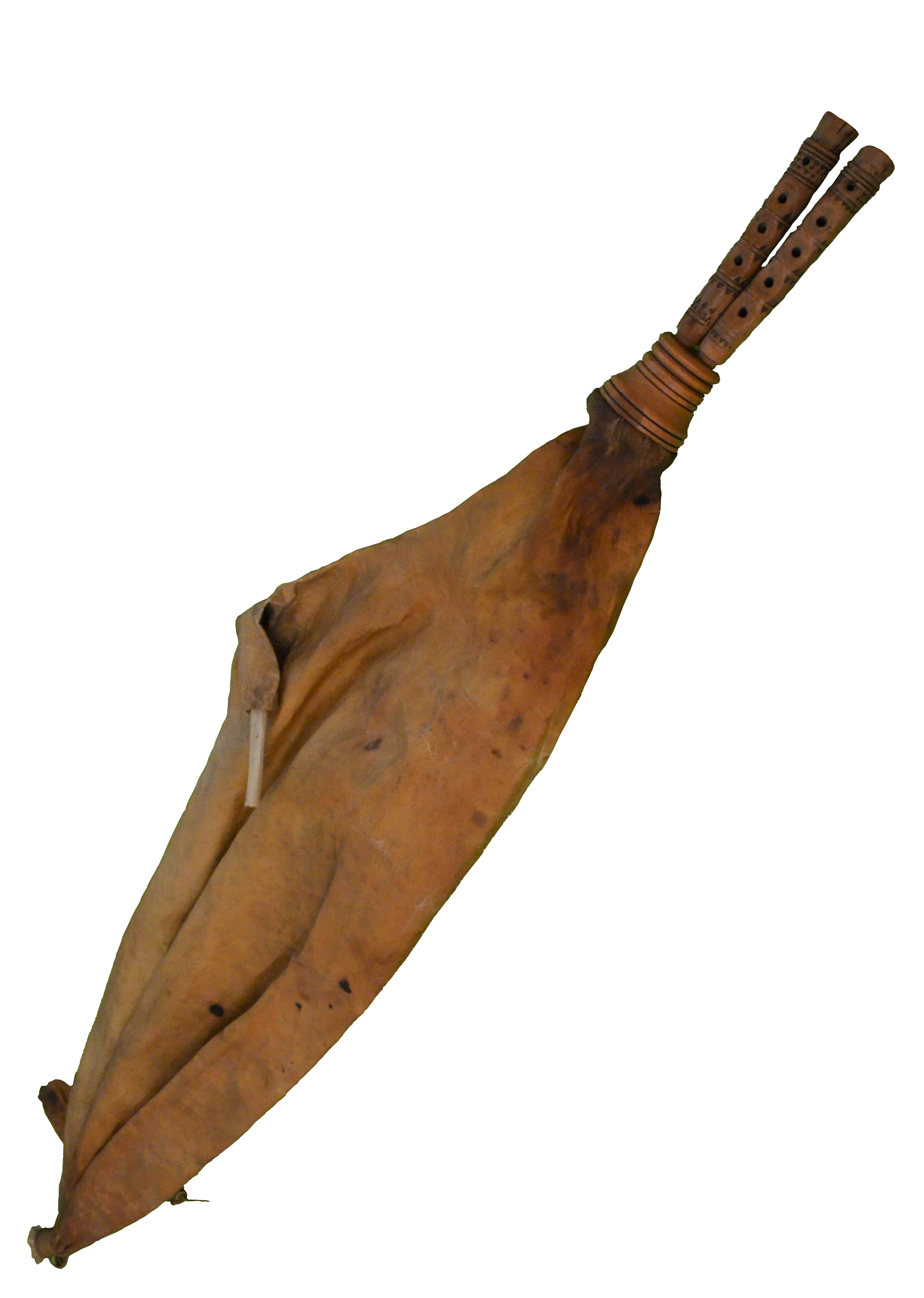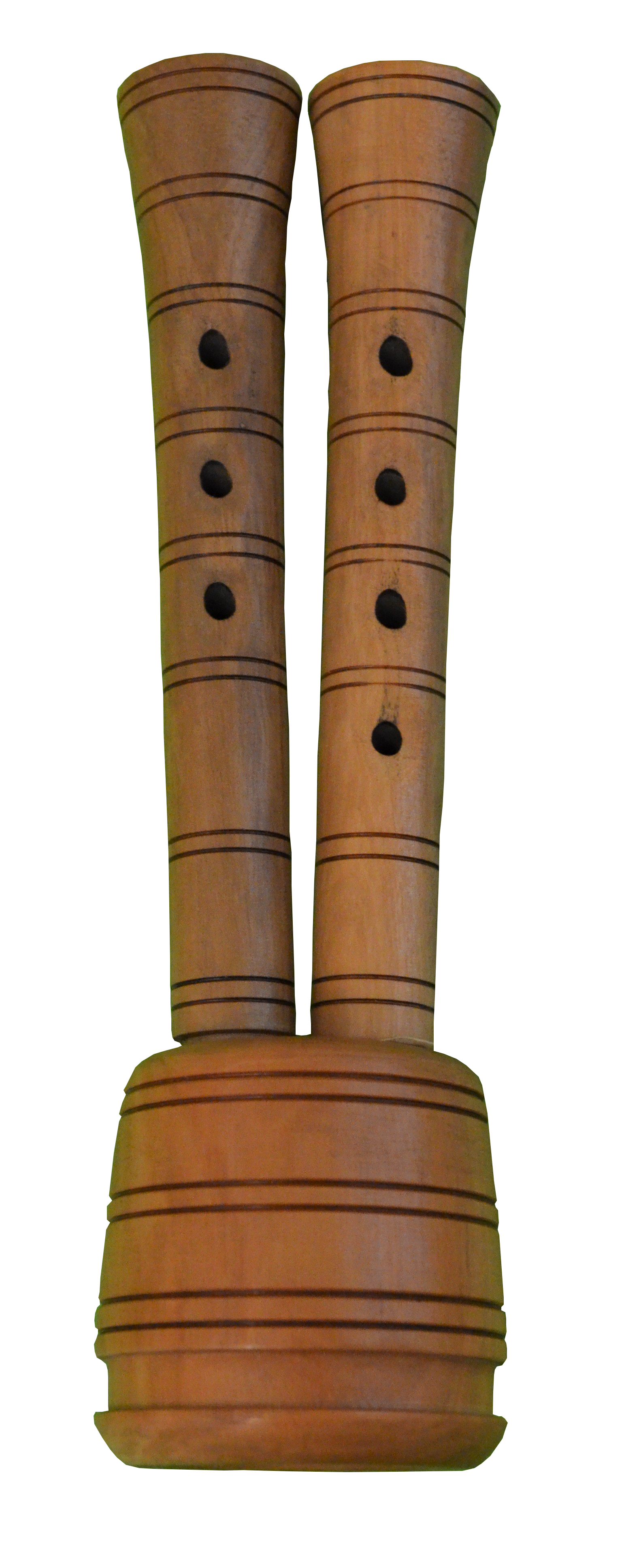Museo Teatrale Carlo Schmidl, Trieste
- CMT inv. 747 - Sopelica
- CMT inv. 748 - Sopelica
- CMT inv. 774 - Dvojnice
- CMT inv. 809 - Mišnice with the bag
- CMT inv. 825 i CMT inv. 826 - Great and small sopela
- CMT inv. 827 i CMT inv. 828 - Great and small sopela
- CMT inv. 902 - Tambourine
- CMT inv.1130 - Small double bass and bow
- CMT inv.152 - Mišnice
- CMT inv.807 - Šurle with the bag (Pive)
- CMT inv.808 - Šurle
- CMT inv.810 - Mišnice
-
Sopelica CMT inv. 747
Zbirka: Museo Teatrale Carlo Schmidl, TriesteEugenio Pinzin
1991. , PorečCane, Hand made
A=275 D2= / E5=16,8 B=230 E1=92 E6= 18 C1=19,5 E2=16 F=14,7 C2= 21 E3=17,5 G=8 D1= 21 E4=16,8 H=6 The instrument has seven finger-holes. The holes were made with scissors and eventually shaped with a reamer. The vent-hole is semicircular. The instrument is made from the cane with the use of billhook. A wooden stopper is inserted into the pipe opening.
-
Sopelica CMT inv. 748
Zbirka: Museo Teatrale Carlo Schmidl, TriesteMartin Glavaš
1985. , PulaWood, Woodturning
A=300 D2= E5=23 B=260 E1=100 E6=23 C1=24 E2=23 F=14 C2=25,5 E3=24 G=8 D1=30 E4=23,5 H=4 The instrument has seven finger-holes, one of which is a thumb hole on the lower side in line with the first. The sopela is decorated with ridges, grooves and decorative parallel rings made with an incandescent wire on a lathe.
-
Dvojnice CMT inv. 774
Zbirka: Museo Teatrale Carlo Schmidl, TriesteMartin Glavaš
1983. , PulaWood, Woodturning, Hand made
A=340 D=31 E4=21 B=290 E1=182 F=13 C=38 E2=21 G=4 E3=21 The instrument has four finger-holes on the right pipe and three on the left. The thumb hole is on the right pipe, level with the first hole. At the top, middle and bottom of the instrument there are geometric decorations and dots made by an incandescent wire. The dvojnice are varnished with clear varnish.
-
Mišnice with the bag CMT inv. 809
Zbirka: Museo Teatrale Carlo Schmidl, TriesteMartin Glavaš
1977. , PulaWood, Skin, Rope, Woodturning, Hand made, Leather processing
chanter stock reeds A=145,7 E1=33 E6=19 H= d1=42,4 B=13,5 E2=20,5 E7=136 I= Ø1=6,4 C1=27,5 E3=20,5 F=6 J= d2=42 C2=24 E4=20 G=3,7 Ø2=6,7 D=21 E5=19 The instrument has a standard number and arrangement of finger-holes . On each tube there is a vent hole. The chanter is decorated with arrow shaped ornaments made with an incandescent wire. The stock has no decorations. The bag is made of goatskin. The blowpipe is decorated with parallel rings made with incandescent wire with on a lathe. The mišnice are lacquered with transparent varnish.
-
Great and small sopela CMT inv. 825 i CMT inv. 826
Zbirka: Museo Teatrale Carlo Schmidl, TriesteMartin Glavaš
1976. , PulaWood, Cane, Woodturning
great A=590 E1=137 E5=30 E9= / B=55 E2=30 E6=30 E10= / C=95 E3=30 E7=75 F=4 D=24 E4=60 E8=/ small A=450 E1=75 E5=25 E9= / B=43 E2=23 E6=25 E7-E1=/ C=85 E3=26 E7=28 F= 4 D=19 E4=25 E8= / Great: The instrument has six finger-holes . The bell has two vent-holes and one of them is drilled through the pipe on both sides. The sopela is decorated with ridges and grooves made on a lathe and parallel rings made with an incandescent wire also with the help of a lathe. The instrument is lacquered with transparent varnish.
Small: The instrument has seven finger-holes on the pipe and the seventh hole (for the little finger) is double. The bell has a vent-hole. The sopela is decorated with ridges and grooves made on a lathe and parallel rings made with an incandescent wire also with the help of a lathe. The instrument is lacquered with transparent varnish. -
Great and small sopela CMT inv. 827 i CMT inv. 828
Zbirka: Museo Teatrale Carlo Schmidl, TriesteIvan Radić
1985.Wood, Metal, Woodturning
great A=550 E1=155 E5=33 E9= / B=70 E2=35 E6=35 E10= / C=80 E3=35 E7=75 F=4,5 D=25 E4=57 E8=/ small A=385 E1=105 E5=23 E7-E9=/ B=33 E2=23 E6=23 E10=/ C=75 E3=23 E7=23 F=4,5 D=23 E4=23 E8= / Great: The instrument has six finger-holes . The bell has two vent-holes and the bottom one is drilled on both sides of the pipe. The upper part of the pipe is reinforced with cast lead. The sopele are decorated with parallel rings made on a lathe, and the bell has an egg-shaped thickening. The instrument is painted and lacquered. This type of sopela is characteristic of the area of the island of Krk and the Kvarner bay.
Small: The instrument has six finger-holes . the pipe has two vent-holes drilled on both side of the pipe. The upper part of the pipe is reinforced with cast lead. The sopela is decorated with parallel rings made on a lathe. The bell is thickened with the help of a lathe and it has two vent-holes with the bottom one drilled on both sides of the pipe. The instrument is painted and lacquered. This type of sopela is characteristic of the area of the island of Krk and the Kvarner bay. -
Tambourine CMT inv. 902
Zbirka: Museo Teatrale Carlo Schmidl, TriesteAntonio Leonardelli
oko/cca 1960. , GaližanaWood, Skin, Metal, Nails, Hand made
Ø (diameter)=350; D (depth)'=105
Simbolo is a type of tambourine that is used in the town of Galižana. It is made of two hoops, the outer and the inner. On the inside part there is a metallic bar. On the bar, there are two bells, metallic rings (6) and small metallic plates (17). On the tambourine there is also a handle. It is white coloured on the outside and yellow from inside.
-
Small double bass and bow CMT inv.1130
Zbirka: Museo Teatrale Carlo Schmidl, TriesteAntonio Raunizza
1886Wood, Metal, Hand made
L (lunghezza)=1350 mm; l (larghezza corpo: inferiore; superiore; in mezzo)=480 mm; 380 mm; 260 mm; L archetto=480 mm
Instrument in the form of a violoncello. There are two screws on which two strings from gut are attached, and originally, the instrument was created as a three strings. The instrument has no soul post, but this function is taken by the left foot of the bridge which goes through the square opening on the soundboard to the bottom. The bass has the end pin with a nail that serves to fix the instrument to the floor. The wooden bow is handmade.
-
Mišnice CMT inv.152
Zbirka: Museo Teatrale Carlo Schmidl, TriesteAnonymous
1939.Wood, Hand made
chanter stock reeds A=126,6 E1=28,2 E6=17,5 H=52,5 d1=49 B=10,6 E2=15,6 E7=/ I=43 Ø1=6 C1=22,8 E3=20,3 F=6 J=27,8 d2=49 C2=21 E4=18 G=3,6 Ø2=5,5 D=17,7 E5=19,6 The instrument has a standard number and arrangement of finger holes. There is no side-hole. The chanter has no particular decorations. The stock is decorated with rings made on the lathe.
-
Šurle with the bag (Pive) CMT inv.807
Zbirka: Museo Teatrale Carlo Schmidl, TriesteAnonymous
2.pol. 19. st./sec. meta' 19. sec/2nd half 19th cent.Wood, Skin, Rope, Bone, Metal, Woodturning, Hand made, Leather processing
chanter stock reeds A=155 E1=51 F=6 H=63 d1=44 B=20 E2=20 G=4,5 I=55,5 Ø1=6,8 C1=20 E3=20 J=42 d2=44 C2=19 E4=20 Ø2=6,8 D=12 E5=20 The right pipe of the instrument has five holes, and the left one four. The lowest hole on each tube serves as the vent-hole. The chanter was entirely handmade while the stock was made later on the lathe. The instrument is decorated with carved ornaments and the stock has parallel rings made on the lathe. The blowpipe is made of animal bone. The bag is tied with a rope and the three small holes are closed with screws.
-
Šurle CMT inv.808
Zbirka: Museo Teatrale Carlo Schmidl, TriesteMartin Glavaš
1983. , PulaWood, Woodturning
chanter stock reeds A=165 E1=63 F=7 H=56,5 d1=43 B=20 E2=19 G=4 I=56,5 Ø1=6,6 C1=29 E3=19 J=62 d2=43 C2=18,5 E4=19,5 Ø2=6,6 D=14,5 The right pipe of the instrument has four finger-holes, and the left one three. On the back side of the right pipe there is another finger-hole. The pipes are decorated with parallel rings made with an incandescent wire on a lathe. The stock has also some circular ornaments, and protrusions and grooves made on a lathe. The šurle are lacquered with transparent varnish.
-
Mišnice CMT inv.810
Zbirka: Museo Teatrale Carlo Schmidl, TriesteGiovanni Fedel
oko/cca 1940. , PulaWood, Hand made
chanter stock reeds A=130 E1=31,4 E6=19 H=56 d1=35 B=15 E2=18 E7=/ I=40,7 Ø1=5 C1=21 E3=18 F=5 J=32 d2=35 C2=21 E4=18 G=4 Ø2=5 D=19,6 E5=16 The instrument has a standard number and arrangement of finger-holes. There is no side-hole. The instrument is entirely handmade. The finger-holes were made with an incadescent wire. The chanter is decorated with thick, straight lines while on the bottom the lines go criss-cross. The stock is decorated in similar way like chanter.

